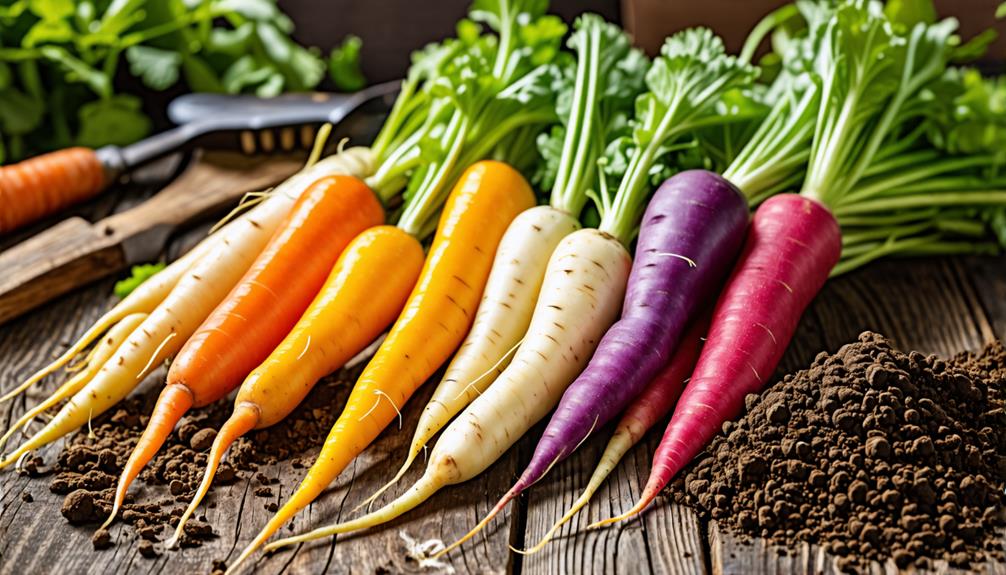You might think you understand carrots, but there's more to these crunchy vegetables than meets the eye. The familiar orange carrot you've been munching on isn't the original version of this root vegetable. In fact, carrots have a surprisingly colorful past that spans centuries and continents. From ancient purple varieties to the Dutch-influenced orange carrots we recognize today, the story of this humble vegetable is filled with unexpected twists and turns. If you've ever wondered why carrots are orange or what other hues they might come in, you're in for a fascinating journey through time and agriculture.
Key Takeaways
- Carrots originally came in various colors, including purple and yellow, before orange became prevalent.
- Orange carrots gained popularity in the 1500s, appearing in Italian and Spanish artworks.
- Dutch farmers selectively bred carrots for sweetness and orange color in the 16th century.
- The orange carrot's association with the Dutch royal family came later, not during initial development.
The Colorful History of Carrots

Imagine biting into a carrot that's not orange, but purple, white, or yellow—that's how our ancestors experienced this versatile vegetable.
Carrots have a surprisingly colorful history that dates back centuries before the familiar orange variety became popular. Originally, these root vegetables came in a rainbow of hues, including purple and yellow.
It wasn't until the 1500s that orange carrots began appearing in Italian and Spanish artworks. The shift to orange was primarily driven by selective breeding practices aimed at enhancing sweetness and visual appeal.
While you might've heard that orange carrots were developed to honor the Dutch royal family, this story actually came much later.
Today, you can still find heirloom varieties in various colors, each offering unique nutrients and flavors. These ancient carrots remind us of the vegetable's diverse heritage.
Selective Breeding and Dutch Influence
While carrots once came in a rainbow of hues, it's the Dutch who played a key role in making orange carrots the norm we recognize today.
Through selective breeding practices, Dutch farmers in the 16th century revolutionized carrot cultivation. They focused on enhancing flavor and color, creating a sweeter, more visually appealing vegetable. These agricultural advancements were particularly successful in the Netherlands, where the climate favored high yields of the vibrant orange variety.
Interestingly, orange carrots first appeared in Italian and Spanish artwork before their widespread cultivation in the Netherlands. However, it was the Dutch who perfected and popularized them.
The orange carrot's rise to prominence was further boosted by its association with the Dutch royal family, particularly William of Orange. This connection transformed the humble vegetable into a symbol of national pride, cementing its place in European diets and global agriculture.
Modern Carrot Varieties Today

You'll find a kaleidoscope of carrot colors in today's markets, ranging from the familiar orange to vibrant purples, yellows, reds, and whites.
These modern orange carrots are the result of selective breeding, offering a sweeter taste that appeals to consumers. However, don't overlook the heirloom varieties like purple and pink carrots, which boast unique flavors and higher antioxidant levels.
The colorful carrots you see aren't just for show; they offer diverse nutritional benefits. Different pigments, such as carotenoids and anthocyanins, contribute to their health properties.
While orange carrots remain a dietary staple worldwide, farmers are now focusing on enhancing sweetness, color, and overall quality to meet market demand.
Conclusion
You've discovered a fascinating aspect of carrot history. The vibrant orange root you enjoy today isn't the original carrot at all.
Through selective breeding and Dutch influence, these vegetables transformed from their multicolored origins.
Next time you're at the farmer's market, look for heirloom varieties to taste the rainbow of carrot flavors.
You'll appreciate how far this humble vegetable has come and perhaps gain a new perspective on the power of agricultural innovation.

Leave a Reply